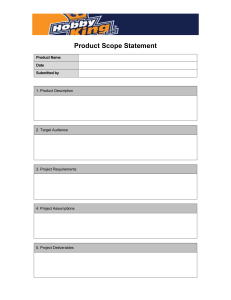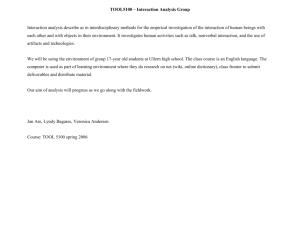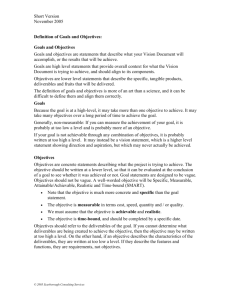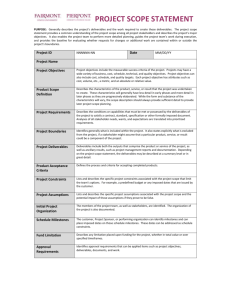Concepts of Project Management
advertisement
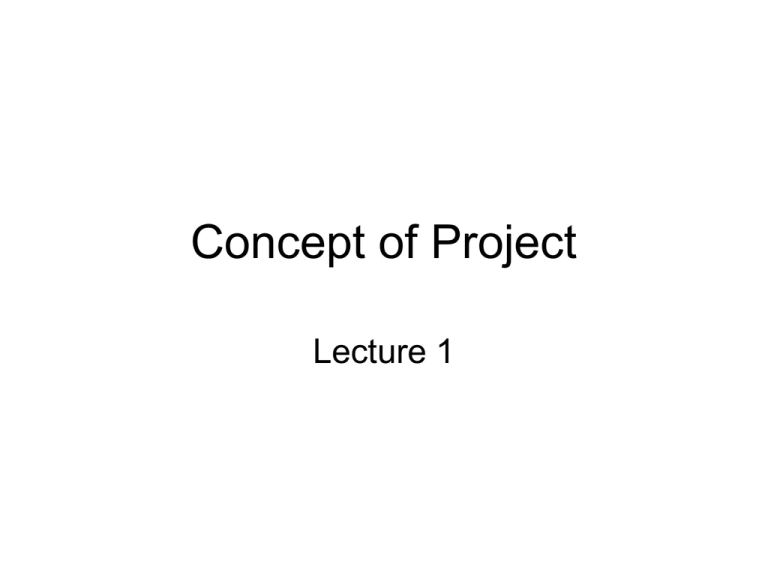
Concept of Project Lecture 1 Project Lifecycle Project Roadmap 1 2 3 4 What is a Project? • Characteristics • • Projects versus Operational Work • • Projects and Strategic Planning *** PMBOK – A Guide to the Project Management Body of Knowledge What is a Project? Characteristics • A project is a unique endeavor to produce a set of deliverables within clearly specified constraints of time, cost and quality • Projects are different from business operations, in terms of uniqueness, timescale, budget, resources, risk and change. What is a Project? Characteristics • Uniqueness. Every project is different from the last, whereas operational activities typically involve repetitive (if not identical) processes. • Timescale. A project has clearly specified start and end dates within which deliverables are produced to meet the customer's requirements. • Budget. A project has a maximum limit to the expenditure within which the deliverables must be produced, to meet the customer's requirement. • Resources. A project is allocated a specified amount of labor, equipment and materials at the start. • Risk. A project entails uncertainty and therefore carries business risk. • Change. The purpose of a project is typically to improve an organization through the implementation of business change. Project versus Operational (1) • Usually share similar characteristics – Performed by people – Constrained by limited resources – Planned, executed and controlled • Unlike operational which is ongoing and repetitive, projects are temporary and unique Project versus Operational (2) • Unique endeavor • Produce a set of deliverables • Clearly specified constraints – Scope – Time – Cost – Quality Project versus Operational (3) • Are unique in nature – No repetitive processes – Different from last project • Have defined timescales – Clear start and end dates – Meet specified customer requirement • Have approved budget – allocated level of financial expenditure – Meet specified customer requirement Project versus Operational (4) • Have limited resources – labor – equipment – Materials • Involve an element of risk – level of uncertainty – carry business risk • Achieve beneficial change – Improve an organization – Implementation of business change Project versus Strategic Planning • Usually organized to address areas beyond an organization's operational limits • Utilized as a means to achieve an organization's strategic plans • Usually authorized as a result or to meet the following strategic considerations – Market Demand – Organizational Need – Customer Request – Technological Advance – A Legal or Regulatory Requirement Concept of Project Management Lecture 2 Why adopt a Project Management Methodology? Without using a methodology from the outset: • Project Teams start building deliverables without defining the project's scope and objective • Project roles and responsibilities are unclear, and lines of communications are undefine • There are no quality targets set, so it's difficult to know when deliverables are really finished • The customer can never be certain of the project's progress or when it is likely to be complete • Project Managers must attempt to manage change, risks and issues "on the fly". Why adopt a Project Management Methodology? By using best practice project management methodology, you will: • Reduce time spent completing project deliverables • Decrease cost by saving time and effort to build deliverables • Minimize change, risks and issues by defining your project properly before you begin • Assure quality of deliverables, increasing your likely of meeting the customer's requirements • Monitor and control the project more efficiently, especially during the Execution phase • Manage suppliers more effectively with comprehensive supplier contracts • Improve staff performance by clarifying roles, responsibilities and delivery expectations Increase the likelihood of overall project success. What is Project Management? • Required – Skills – Tools – Processes • Undertake a Project successfully What is Project Management? (1) (Formal Definitions) • PMBOK® "The PMBOK is the sum of knowledge within the profession of project management that is standardized by ISO.“ • PRINCE2 "The planning, monitoring and control of all aspects of the project and the motivation of all those involved in it to achieve the project objectives on time and to the specified cost, quality and performance.“ • PROJECT A temporary endeavour with a finite completion date undertaken to create a unique product or service. Projects bring form or function to ideas or needs. What is Project Management? (2) (Formal Definitions) • DIN 69901 "Project management is the complete set of tasks, techniques, tools applied during project execution“ • ISO 10006:2003 "Planning, organizing, monitoring, controlling and reporting of all aspects of a project and the motivation of all those involved in it to achieve the project objectives." Aspects of Project Management • Skills • Tools • Processes Aspects of Project Management Skills • Specialist knowledge • Skills • Experience Aspects of Project Management Tools • Various types of tools – Specialized methodologies – Computer hardware and software – Monitoring and Measuring Equipment – Documentation systems • Examples – Document templates – Records register – Planning software – Audit checklist – Review forms Aspects of Project Management Processes • Management techniques and processes to monitor and control – Time – Cost – Quality – Scope • Examples – Time management – Cost management – Change management – Risk management – Issue Management Knowledge Areas in Project Management (1) • Project Integration Management – Chartering – Scoping – Project Plan – Execution – Monitoring and Control – Change Control – Closure • Project Scope Management – Planning – Scope Definition – Work Breakdown Structure – Scope Control Knowledge Areas in Project Management (2) • Project Time Management – Sequencing – Resource and Duration Estimating – Schedule Development and Control • Project Cost Management – Estimating – Budgeting – Control • Project Quality Management – Quality Planning – Quality Assurance and Control Knowledge Areas in Project Management (3) • Project Time Management – Sequencing – Resource and Duration Estimating – Schedule Development and Control • Project Cost Management – Estimating – Budgeting – Control • Project Quality Management – Quality Planning – Quality Assurance and Control Knowledge Areas in Project Management (4) • Project Procurement Management – Plan Purchase and Acquisition – Supplier Selection – Contract Administration and Closure Project Management Triangle • Time • Cost • Scope Concept of the Triple Constraint • All project need to be performed and delivered under certain constraints • These are scope, time and Cost • Known as the "Project Management Triangle" • These factors are interdependent and changes in one affects the other factors • These factors directly affect the "fourth constraint" which is quality • Sometimes, "Labor" replaces the "Scope“ constraint in some Project Management models Concept of the Triple Constraint Time The time-related processes aim to determine dependencies and the duration of activities and to ensure timely completion of the project. The time-related processes are: - Planning of activity dependencies - Estimation of duration - Schedule of development - Schedule control …addresses the issues of “overtime” and “delays” Concept of the Triple Constraint Cost The cost-related processes aim to forecast and manage the project costs. This should ensure that the project is completed within budget constraints, and that cost information can be provided to the originating organization. The cost-related processes are: - Cost estimation - Budgeting - Cost control …addresses the issues of “over costs” and “deficits” Concept of the Triple Constraint Scope • Overall definition of what is to be accomplished • Specific description of the end results (e.g. quality) • Sometimes, replaced or synonymous with Specification. …addresses the issues of “scope creep” and “under scope” Project Management Activities (1) • • • • • • • • • • • Analysis and design of objectives and events Planning the work according to the objectives Assessing and controlling risk (or Risk Management) Estimating resources Allocation of resources Organizing the work Acquiring human and material resources Assigning tasks Directing activities Controlling project execution Tracking and reporting progress Project Management Activities (2) • • • • • • • • • • • Analyzing the results based on the facts achieved Defining the products of the project Forecasting future trends in the project Quality Management Issues management Issue solving Defect prevention Identifying, managing & controlling changes Project closure (and project debrief) Communicating to stakeholders Increasing / decreasing a company's workers Overall Project Objectives (1) Overview – Project objectives define targets and performance indicators for specific target deliverables at the end of the project. Overall Project Objectives (1) SMA[A]RT[ER] Criteria • Specific (or Significant, Stretching, Simple) • Measurable (or Meaningful, Motivational, • Manageable) • Achievable (or Agreed, Attainable, Assignable, • Appropriate, Actionable, Action-oriented) • [Acceptable] • Realistic (or Relevant, Results-oriented, • Resourced, Rewarding) • Time-bound (or Timely, Time-Specific, Trackable) • [Ethical] (or Exciting, Evaluated) • [Recorded] (or Rewarding, Reviewed) Overall Project Objectives (2) DUMB Criteria • Doable • Understandable • Manageable • Beneficial Usual Outputs / Deliverables (1) • • • • • • • • • • • • • • Project Charter Preliminary Scope Statement / Statement of work Business case / Feasibility Study Scope Statement / Terms of reference Project management plan / Project Initiation Document Work Breakdown Structure Change Control Plan Risk Management Plan Risk Breakdown Structure Communications Plan Governance Model Risk Register Issue Log Usual Outputs / Deliverables (2) • • • • • • • • Action Item List Resource Management Plan Project Schedule Project Status Report Responsibility assignment matrix Database of lessons learned Stakeholder Analysis Document Management External Factors • Risk – Often defined as potential points of failure – Usually associated with "negative" events – Can also be categorized as "positive" events (e.g. optimization risk, faster completion rates) • Customers – Either internal (e.g. persons/groups in the organization) or external (e.g. customer, agencies or regulators) – May dictate the time, cost and scope of the project – Area of negotiation and balancing of resources versus client requirements External Factors • Suppliers – Either internal (e.g. persons/groups in the organization) or external (e.g. approved supplier, client supplied) – Usually a very critical area for monitoring – Relationship with suppliers is usually the "key” Sample Approaches • • • • • • General Types / Classifications Traditional / Standard Methodology Ad-Hoc Methodology Non-Traditional Methodology Process-based Methodology Industry-initiated Methodology Sample Approaches General Types / Classification • Regardless of the name, specific aspects of the methodology, features… all approached can be classified under these types: – Linear (e.g. Waterfall) – Prototyping (small, quick and dirty) – Incremental (e.g. SCRUM) – Spiral (cyclical, iterative, build-up) – Rapid Application Development (e.g. Agile) Sample Approaches Traditional /Standard Methodology • PMBOK Guide • PRINCE2 (PRojects IN Controlled Environments Ver. 2) • Standard "Waterfall"-type methods • System Development Life Cycle (SDLC) Sample Approaches Ad-Hoc Methodology • Non-formal methodology • "Sari-sari store" methodology • Action-oriented Entrepreneurship Sample Approaches Non-Traditional Methodology • • • • Joint Application Development (JAD) Agile Software Development Rapid Application Development (RAD) Dynamic Systems Development Method (DSDM) • Extreme Programming (XP) • SCRUM Sample Approaches Process-based Methodolgy • ISO 9001:2000 / ISO 10006:2003 CMMI Ver.1.2 – CMMI for Developers (CMMI-DEV) – CMMI for Acquisition (CMMI-ACQ) – CMMI for Service (CMMI-SVC) • ISO/IEC 15504 Series (9 parts) – Software Process Improvement and Capability Determination Sample Approaches Industry Methodology • RUP (Rational Unified Process) – Developed by Rational Software (a part of IBM) • OpenUP (Open Unified Process) – Based on RUP, part of Eclipse Process Framework Components of Project Management • Project Management System – Formal management system – Core of any project organization – With aspects for management, monitoring and control of project processes – Start and end of any project endeavour • Project Stages – Initiation – Planning and Design – Execution – Closure Sample PM Tools • • • • • Financial Estimation Tools Quality Control Tools Scheduling Tools Resourcing Tools Software Tools – Open Source – Proprietary Sample PM Tools Financial Estimation Tools • • • • Job Cost Accounting Predictive Analysis Reference Class Forecasting Value Engineering Sample PM Tools Quality Control Tools • • • • • • • Ishikawa diagram Pareto diagram Check sheet Control chart Flowchart Histogram Scatter diagram Sample PM Tools Scheduling Tools • • • • PERT / CPM GANTT Event Chain chart WBS Sample PM Tools Resourcing Tools • RACI Diagrams / Matrix • Participatory Impact Pathways Analysis Sample PM Tools Open Source Software Tools • Open-source Desktop – GanttProject – OpenProject – OpenWorkbench • Open-source Web-based – eGroupWare – dotProject – Project.net Sample PM Tools Proprietary Software Tools • • Commercial Desktop – Artemis – InLoox – Planisware 5 – Primavera Project Planner – RationalPlan Commercial Web-based – @task – Clarity – Daptiv – Genius Inside – OpenAir – Planisware OPX2 – Teamwork Standards and References • PMBOK Guide, 3rd Edition – A Guide to the Project Management Body of Knowledge • PRINCE2 (OGC-UK) – PRojects IN Controlled Environments • VEE-Model (German) – Systems development model designed to simplify the understanding of the complexity associated with developing systems. – In systems engineering it is used to define a uniform procedure for product of project development. Standards and References • HERMES Ver.2003 (Swiss) – Based on the VEE-model, and specific for ICT projects • OPM3 (PMI) – Organizational Project Management Maturity Model • ISO 9001:2000 / ISO 10006:2003 – Quality Management Systems - Guidelines for quality management in projects • CMMI (CMU-SEI) – Capability Maturity Model Integration • TCM Ver.2006 (AACE) – Total Cost Management • Method 123 Project Management Methodology (MPMM)
